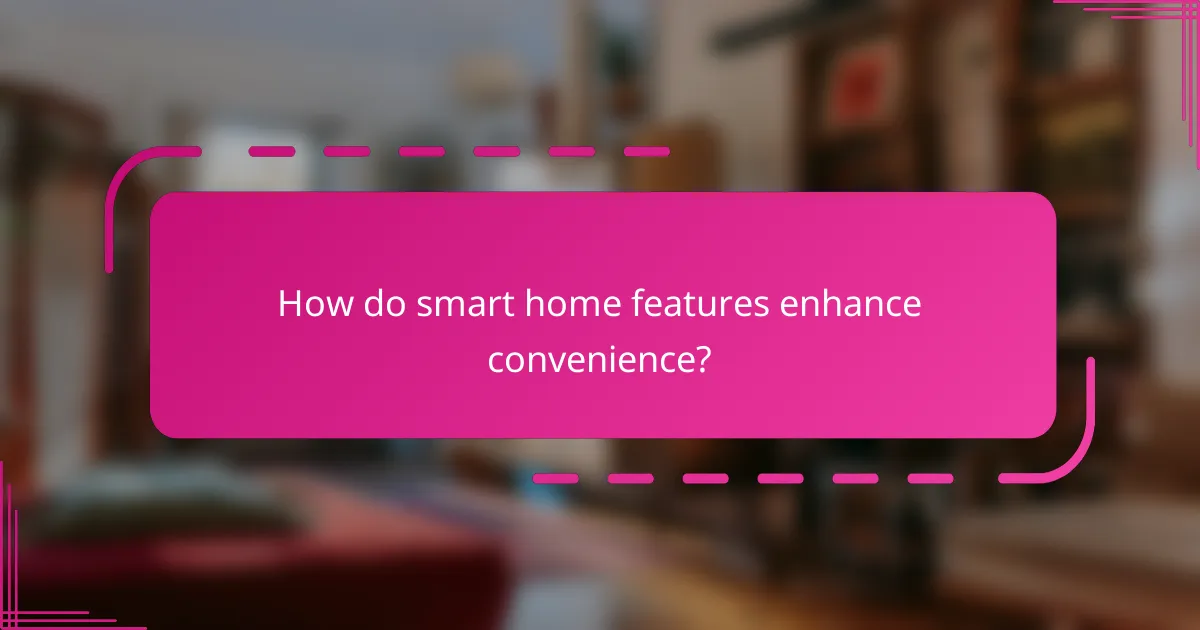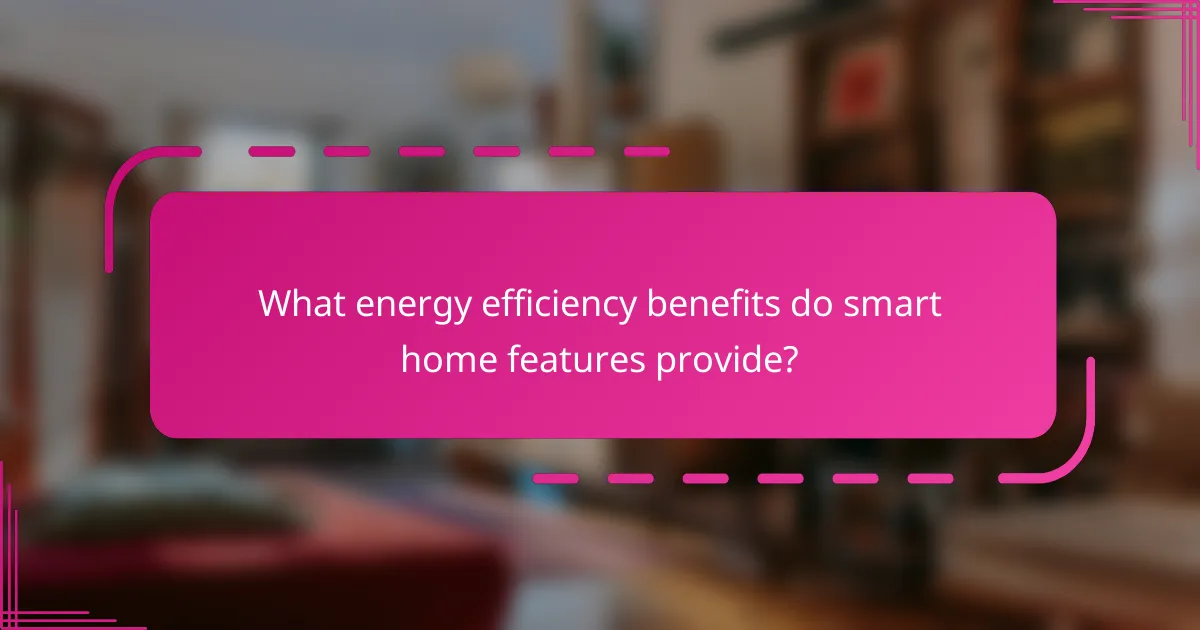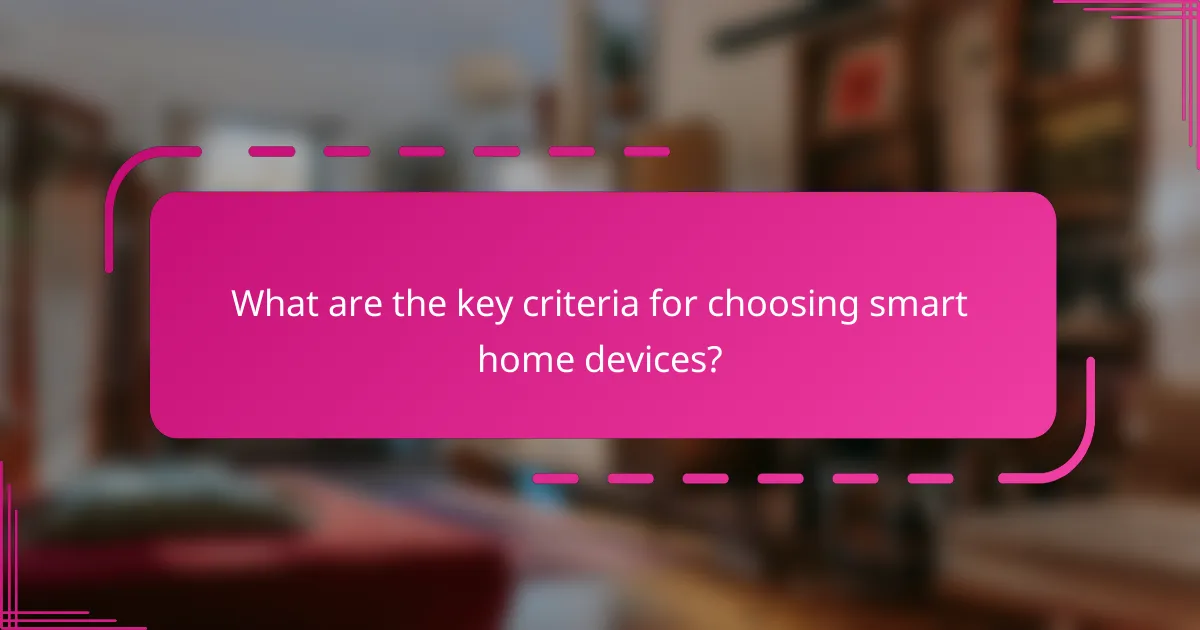Smart home features offer a transformative approach to modern living by enhancing convenience, energy efficiency, and security. With automation at the forefront, these technologies simplify daily tasks, optimize energy consumption, and provide robust security measures, ensuring a more comfortable and safer home environment. Embracing smart home solutions not only streamlines routines but also contributes to a sustainable lifestyle and peace of mind.

How do smart home features enhance convenience?
Smart home features significantly enhance convenience by automating daily tasks and allowing users to control their home environment effortlessly. These technologies streamline routines, making it easier to manage everything from lighting to temperature with minimal effort.
Voice control with Amazon Alexa
Voice control through Amazon Alexa allows users to operate various smart devices hands-free. By simply speaking commands, you can adjust lighting, play music, or even check the weather, making daily tasks quicker and more efficient.
To get started, ensure your devices are compatible with Alexa and set them up through the Alexa app. Consider creating routines that automate multiple actions with a single command, such as turning off all lights and locking doors at bedtime.
Automated lighting systems
Automated lighting systems enable you to schedule lights to turn on or off at specific times, enhancing both convenience and energy efficiency. You can also adjust brightness levels or colors through mobile apps or voice commands, creating the perfect ambiance for any occasion.
When selecting a system, look for options that integrate with other smart home devices. This can allow for synchronized lighting with security systems or entertainment setups, providing a seamless experience throughout your home.
Smart thermostats like Nest
Smart thermostats, such as Nest, learn your heating and cooling preferences over time, automatically adjusting temperatures for optimal comfort and energy savings. They can be controlled remotely via smartphone apps, allowing you to make changes even when you’re away from home.
Consider setting up geofencing features that adjust the temperature based on your location, ensuring your home is always at a comfortable temperature when you arrive. This not only enhances convenience but can also lead to significant savings on energy bills.
Remote access via mobile apps
Remote access through mobile apps allows you to monitor and control your smart home devices from anywhere. Whether you want to check security cameras or adjust the thermostat while at work, having this capability adds a layer of convenience to your daily life.
Ensure that your devices are connected to a secure Wi-Fi network and that you regularly update the apps for optimal performance. Familiarize yourself with the features available in the app to maximize the benefits of remote access, such as receiving alerts or managing multiple devices simultaneously.

What energy efficiency benefits do smart home features provide?
Smart home features enhance energy efficiency by optimizing energy consumption and reducing waste. These technologies allow homeowners to monitor and control their energy use, leading to lower utility bills and a smaller carbon footprint.
Energy monitoring with Sense
Energy monitoring systems like Sense provide real-time insights into energy consumption throughout the home. By identifying which devices use the most energy, homeowners can make informed decisions about usage patterns and potential upgrades. This can lead to reductions in energy costs of up to 20% or more.
To maximize benefits, consider placing the monitoring device in a central location and regularly reviewing the data. This helps in identifying trends and making adjustments as needed.
Smart plugs for appliance control
Smart plugs allow users to control appliances remotely, enabling them to turn devices off when not in use. This simple action can significantly reduce standby power consumption, which often accounts for a notable portion of energy bills.
When using smart plugs, look for models that offer scheduling features, allowing you to automate on/off cycles based on your routine. This can further enhance energy savings by ensuring devices are only powered when needed.
Programmable thermostats
Programmable thermostats automatically adjust heating and cooling settings based on user-defined schedules, leading to substantial energy savings. By optimizing temperature settings during peak and off-peak hours, homeowners can reduce energy waste significantly.
For best results, set your thermostat to lower temperatures in winter and higher in summer when you’re away. Many models can be controlled via smartphone apps, providing flexibility and convenience.
Solar panel integration
Integrating solar panels into your smart home system can drastically reduce reliance on grid electricity. By generating your own power, you can lower energy costs and potentially earn credits through net metering, depending on local regulations.
When considering solar panel integration, evaluate your energy needs and local incentives. Many regions offer tax credits or rebates, making the initial investment more manageable and enhancing long-term savings.

How do smart home features improve security?
Smart home features enhance security by integrating advanced technology to monitor and control access to your home. These systems provide real-time alerts, remote access, and automated responses to potential threats, making it easier to protect your property.
Smart locks like August
Smart locks, such as those offered by August, allow you to control access to your home remotely. You can lock or unlock your door using a smartphone app, set temporary access codes for guests, and receive notifications when someone enters or exits.
When choosing a smart lock, consider compatibility with your existing door hardware and whether it offers features like auto-locking or integration with other smart home devices. Look for models that support encryption for added security.
Security cameras from Ring
Ring security cameras provide real-time video surveillance of your property, allowing you to monitor activity from anywhere. These cameras often include features like motion detection, night vision, and two-way audio, enhancing your ability to respond to potential intruders.
When selecting a security camera, consider factors such as resolution, field of view, and storage options. Many Ring cameras offer cloud storage plans, which can vary in cost based on the amount of footage you want to retain.
Alarm systems with ADT
ADT offers comprehensive alarm systems that include professional monitoring services. These systems can detect unauthorized entry, smoke, and carbon monoxide, providing alerts to both you and emergency services.
When evaluating an alarm system, consider the types of sensors included, the monitoring options (self-monitored vs. professionally monitored), and any additional features like home automation integration. Monthly monitoring fees can vary widely, so review your budget accordingly.
Motion sensors for alerts
Motion sensors can be a crucial part of your home security setup, as they detect movement and trigger alerts. These sensors can be placed indoors or outdoors and can be integrated with your smart home system for real-time notifications.
When installing motion sensors, consider the coverage area and sensitivity settings to minimize false alarms. Look for sensors that can differentiate between pets and humans to avoid unnecessary alerts.

What are the key criteria for choosing smart home devices?
When selecting smart home devices, consider compatibility with your existing systems, ease of installation, and the cost relative to features offered. These criteria ensure that your devices work seamlessly together, are user-friendly, and provide good value for your investment.
Compatibility with existing systems
Compatibility is crucial when integrating smart home devices. Ensure that new devices can communicate with your current systems, such as smart hubs or voice assistants. Check for compatibility with popular platforms like Amazon Alexa, Google Assistant, or Apple HomeKit.
Before purchasing, review the specifications and user reviews to confirm that the devices you choose will work together. Devices that support common protocols like Zigbee or Z-Wave often offer better interoperability.
Ease of installation
Ease of installation can significantly impact your experience with smart home devices. Many products are designed for simple DIY installation, requiring minimal tools and technical knowledge. Look for devices that come with clear instructions and user-friendly apps.
Consider whether the device requires professional installation, which can add to the overall cost. If you prefer a hassle-free setup, opt for devices known for their straightforward installation processes.
Cost versus features
Evaluating cost versus features is essential to ensure you get the best value for your money. While some devices may have a lower upfront cost, they might lack essential features or require costly subscriptions for full functionality.
Compare similar devices within your budget to identify which features are most important to you. For example, a smart thermostat may offer energy savings but could have varying price points based on advanced features like remote access or learning capabilities.
